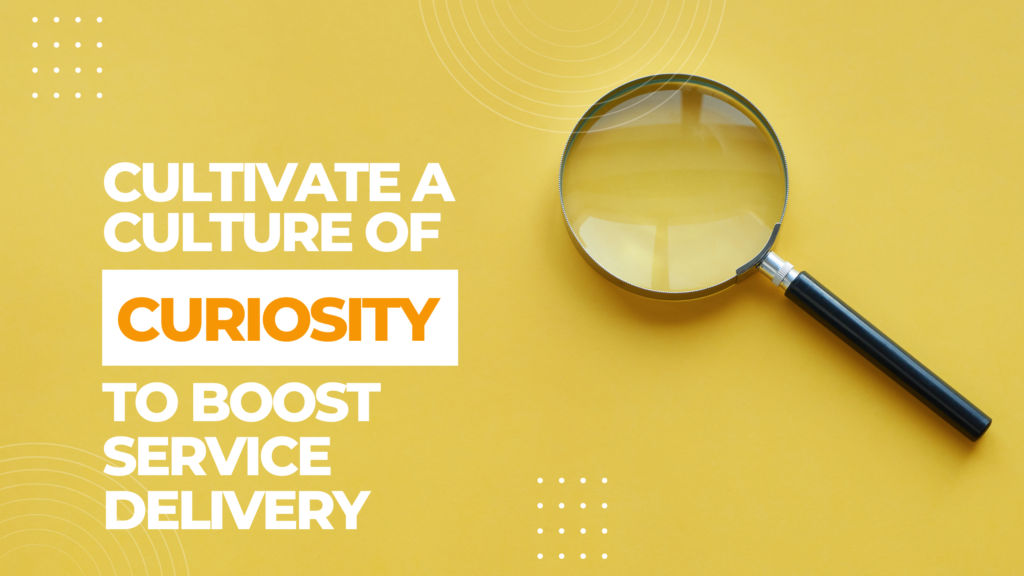Generally, I get really excited when I speak with a C-suite or senior leader who is excited about having his or her business become known for delivering a stellar customer experience. I get even more excited when I realize that he or she has a beginner’s mind and is curious about the ins and outs of transforming the business into one that is loved and adored by its customers.
Typically, a culture of curiosity relates to the attitude of openness to learning and innovation, as well as questioning what exists, with the intention of generating improvement. What I don’t come across often, is intentional curiosity about specific customer experience markers. So, let’s take a look at the questions that business leaders should be asking, to really drive customer experience change and impact.
A culture of curiosity relates to the attitude of openness to learning and innovation, as well as questioning what exists, with the intention of generating improvement.
“How effective is our internal service orchestration on a daily basis?” Firstly, this question addresses the efficiency with which departments have mastered inter and intra-departmental operations and eliminated silo-style functioning. Secondly, emphasis here is on the “daily basis.” Effective orchestration has to be mandated, so that it becomes a way of life in a business.
If it becomes mandatory that departments give an account of their service performance, every day, I would predict that many repetitive mistakes will be eliminated, especially if there are managerial sanctions attached. Additionally, this question places departments under pressure to eliminate sloppiness, to master the art of horizontal collaboration and to own responsibility for delivering basic transaction promises. Getting internal service orchestration right is critical to moving customers seamlessly across departments and channels.
“How effective is our internal service orchestration on a daily basis?”
“What return on our investment in customer experience effectiveness are we achieving?” This, of course, speaks to revenue and cost-impacting outcomes. The revenue-impacting side would question the level of repeat business, the number of actual customer recommendations (NPS), the number of employee commendations and the scale of bragging rights about customer fandom. A huge cost-impacting question would be the cost of service failures.
How many businesses calculate the cost of poor service? Very few, I suspect, notwithstanding the fact that there is a formula for this calculation. The problem is that in many businesses, there is no system for capturing the data to be costed. If customer sentiment regarding a concluded transaction is not measured, then it can’t be costed. If it’s not costed, then intelligence about the true revenue impact of poor service is incalculable.
“What return on our investment in customer experience effectiveness are we achieving?”
“Why is our existing customer-serving model not creating service delivery and customer experience consistency across all transaction channels?” Maybe we can look to elite teams that win medals for some insights before responding to this question. These teams understand their single mission, they have an endgame vision and they have playbooks that drive the team to function in a cohesive and connected manner. When a business has a service excellence vision statement, a stated service brand and clearly defined service standards, it’s a good start to building out consistency in delivery and a rigour-based, service model.
I’ve met many chief executive officers who feel overwhelmed by the “underwhelming” state of service in their various businesses. Curiosity can be a powerful antidote to the sense of overwhelm, when applied properly. The trick is to become curious about the right questions that should be asked at the top of a customer experience improvement journey and then to translate the outcomes of this curiosity into programmable actions that form part of a larger strategy.
The trick is to become curious about the right questions that should be asked at the top of a customer experience improvement journey and then to translate the outcomes of this curiosity into programmable actions that form part of a larger strategy.
Here’s a wild thought and a final question. Shouldn’t workplaces be spaces where everyone, from C-suite to junior staff, is encouraged to be curious and to think in novel ways? Cultivating a culture of true curiosity can generate moments of insight that support service excellence.
Buckminster Fuller says that, “You never change things by fighting the existing reality. To change something, build a new model that makes the existing model obsolete.”
Maybe leaders can begin to address the service issues in their businesses by adopting a new model that is guided by a list of “essential questions” and powered by “curious enquiry,” that unleashes fresh intelligence to existing challenges.
For those leaders who are interested, I have a full list of essential questions.

